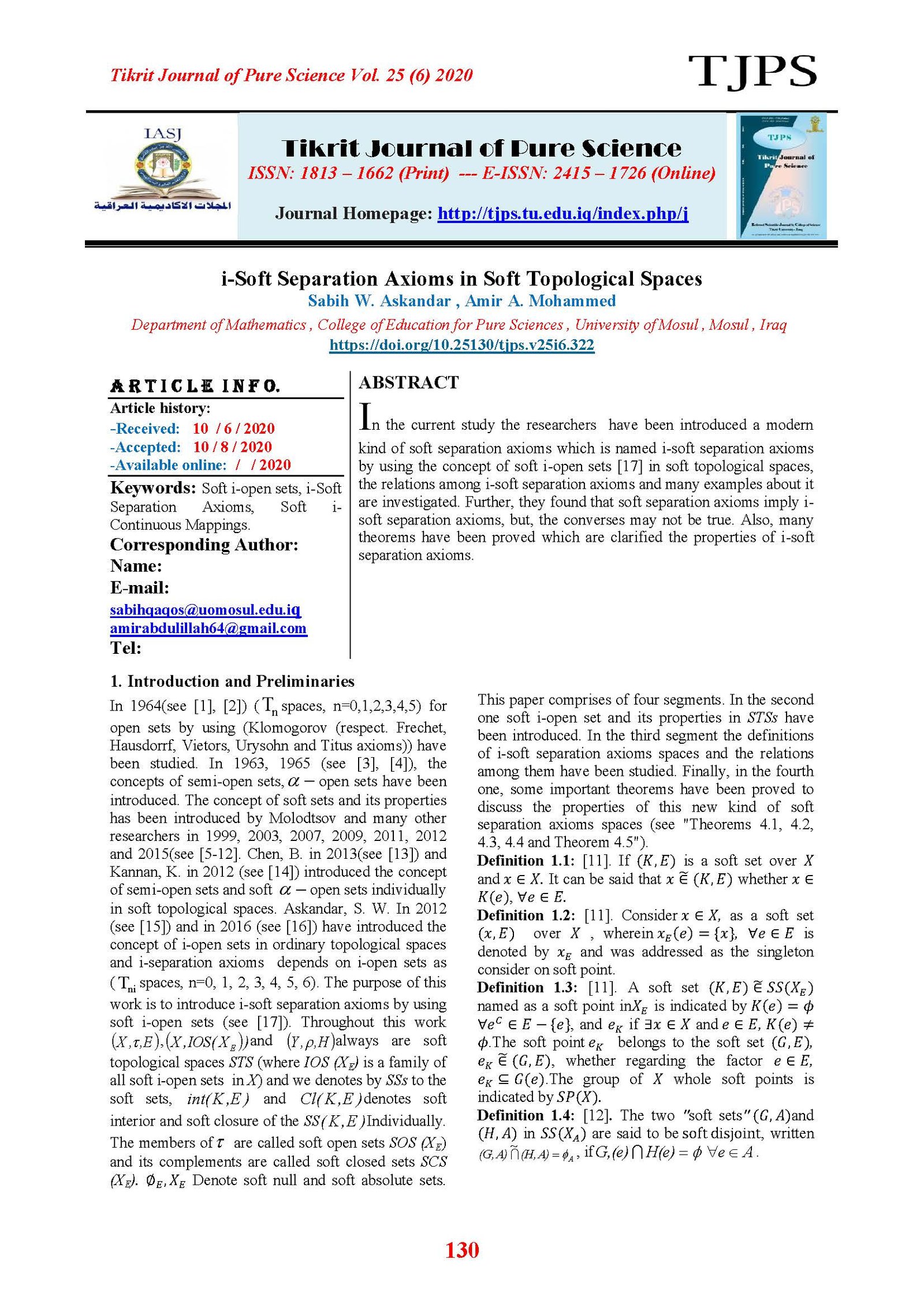i-Soft Separation Axioms in Soft Topological Spaces
Main Article Content
Abstract
In the current study the researchers have been introduced a modern kind of soft separation axioms which is named i-soft separation axioms by using the concept of soft i-open sets [17] in soft topological spaces, the relations among i-soft separation axioms and many examples about it are investigated. Further, they found that soft separation axioms imply i-soft separation axioms, but, the converses may not be true. Also, many theorems have been proved which are clarified the properties of i-soft separation axioms
Article Details

This work is licensed under a Creative Commons Attribution 4.0 International License.
Tikrit Journal of Pure Science is licensed under the Creative Commons Attribution 4.0 International License, which allows users to copy, create extracts, abstracts, and new works from the article, alter and revise the article, and make commercial use of the article (including reuse and/or resale of the article by commercial entities), provided the user gives appropriate credit (with a link to the formal publication through the relevant DOI), provides a link to the license, indicates if changes were made, and the licensor is not represented as endorsing the use made of the work. The authors hold the copyright for their published work on the Tikrit J. Pure Sci. website, while Tikrit J. Pure Sci. is responsible for appreciate citation of their work, which is released under CC-BY-4.0, enabling the unrestricted use, distribution, and reproduction of an article in any medium, provided that the original work is properly cited.
References
[1] Pervin W.J. (1985). Foundations of General
Topology, Mosul University: Translated by Attallah
Thamir Al-Ani.
[2] Pervin W.J. (1964). Foundations of General
Topology, New York: Academic Press Inc: 201 pp.
[3] Levine N. (1963). Semi-open sets and semicontinuity
in topological space, Amer. Math.,
Monthly, 70: 36-41.
[4] Njastad O. (1965). On some classes of nearly
open sets, Pacific J. Math., 15: 961-970.
[5] Molodtsov D.A. (1999). Soft set theory-first
results, Comp. Math. App., 37(4): 19-31.
[6] Maji P. K.; Biswas R. and Roy A. R. (2003). Soft
set theory, Comp. Math., App., 45(4): 555-562.
[7] Aktas H. and Cagman N. (2007). Soft sets and
soft groups, Information Sciences, 1(77): 2726-2735.
[8] Ali M. I.; Feng F.; Liu X.; Min W. K. and Shabir
M. (2009). On some new operations in soft set theory,
Comp. Math. App., 57(9): 1547-1553.
[9] Shabir M. and Naz M. (2011). On soft topological
space, Comp. Math., App., 61(7): 1786-1799.
[10] Hussain S. and Ahmad B. (2011). Some
properties of soft topological spaces, Comp. Math.,
App. 62(11): 4058-4067.
[11] Zorlutuna I.; Akdag M.; Min W.; and Atmaca S.
(2012), Remarks on soft topological spaces, Annals of
fuzzy mathematics and informatics, 3(2): 171-185.
[12] Hussain S. (2015). A note on soft connectedness,
Journal of Egyptian Mathematical society, 23(1): 6-
11.
[13] Chen B. (2013). Soft semi-open sets and related
properties in soft topological spaces, Appl. Math. Inf.
Sci., 7(1): 287-294.
[14] Kannan K. (2012). Soft generalized closed sets
in soft topological spaces, journal of theoretical and
applied information technology, 37(1): 17-21.
[15] Askandar S.W. (2012). The property of extended
and non-extended topologically for semi-open,
